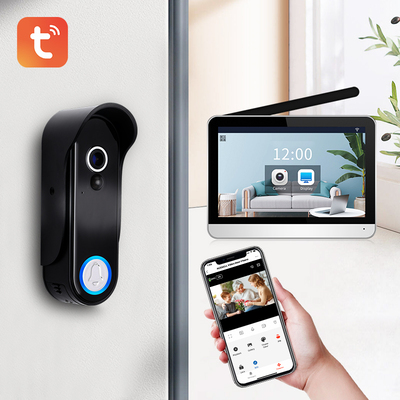触摸屏智能无线可视门铃:设计与优化
Time:2024-03-19 13:43:14 Views:79次
Introduction:
With the advancement of technology, smart home devices have become increasingly popular. Among them, the touchscreen intelligent wireless visual doorbell plays a crucial role in home security systems. This article will delve into various aspects of the touchscreen intelligent wireless visual doorbell, including size and shape, sensitivity, response speed, multi-touch, anti-interference capability, and user interface design, and provide insights into future developments.
Size and Shape:
The size and shape of the touchscreen are crucial for user experience and installation adaptability. An appropriate size can provide sufficient display area to meet users' information viewing needs while maintaining the aesthetic appeal of the doorbell. For instance, a doorbell with a 5-7 inch screen size strikes a balance between displaying clear monitoring images and maintaining an appealing appearance. Additionally, considerations should be given to the thickness of the border and the curvature of the screen to enhance the product's aesthetics and user comfort.
Sensitivity:
The sensitivity of the touchscreen directly affects the smoothness and accuracy of user operations. A highly sensitive touchscreen can accurately capture user touch actions and respond promptly. For example, when users lightly touch or swipe the screen, the system should accurately identify and execute corresponding functions, such as viewing monitoring screens or activating intercom functions. To achieve high sensitivity, high-quality touch sensors and advanced touch control technologies should be employed to ensure smooth user experience and accurate operations.
Response Speed:
The response speed of the touchscreen directly impacts users' perception of the doorbell system. A fast response speed can make users feel the immediacy and efficiency of the doorbell, thereby enhancing user experience. For example, after users touch the screen, the system should respond immediately by displaying menu options or adjusting settings. To achieve fast response speed, software algorithms and hardware performance should be optimized to improve the touchscreen's response speed and processing capabilities.
Multi-touch:
Some advanced touchscreens support multi-touch functionality, allowing users to perform operations using multiple fingers simultaneously, such as zooming or rotating. For example, while viewing monitoring screens, users can zoom in or out by using two fingers, enabling them to see details more clearly. The application of multi-touch technology can make the doorbell system more interactive and flexible, enhancing users' sense of control and satisfaction.
Anti-Interference Capability:
Since touchscreens are often used in outdoor environments where they may be subjected to various environmental conditions, it is essential to have a certain degree of anti-interference capability to ensure the system's stability and reliability. For instance, the touchscreen should be able to function properly under intense sunlight or heavy rain, without being affected by external factors such as glare or water mist. To enhance anti-interference capability, considerations should be given to the selection of screen materials and the implementation of waterproof and dustproof measures, ensuring the touchscreen's stability and reliability.
User Interface Design:
The user interface design of the touchscreen is crucial for user experience and ease of operation. A well-designed interface should be intuitive, with appropriately sized buttons, allowing users to operate the doorbell easily in various situations. Furthermore, the interface layout should be rational, with easily understandable and accessible function options to enhance user experience and operational convenience. For instance, placing commonly used functions on the main screen, providing clear icons and text labels, enables users to quickly find the desired functions. Additionally, personalized settings options can be introduced, allowing users to adjust the doorbell system settings according to their preferences, such as brightness adjustment and sound settings, enhancing user personalization and satisfaction.
Conclusion:
The touchscreen intelligent wireless visual doorbell plays a vital role in enhancing home security systems and user experience. By carefully considering and optimizing aspects such as size and shape, sensitivity, response speed, multi-touch capability, anti-interference capability, and user interface design, the doorbell system can be made more user-friendly, stable, and reliable, providing a superior user experience.
Future Outlook:
As smart home technology continues to evolve and become more widespread, touchscreen intelligent wireless visual doorbells will see further innovation and development in the future. We can anticipate the application of more advanced touchscreen technologies, such as higher-resolution screens and support for more gesture operations, to enhance user experience. Additionally, with the advancement of artificial intelligence and Internet of Things (IoT) technologies, touchscreen intelligent wireless visual doorbells may incorporate more intelligent features, such as facial recognition and integration with voice assistants, to provide users with more convenient and secure home experiences.
In conclusion, the touchscreen intelligent wireless visual doorbell has significant potential and development space in enhancing home security, user experience, and quality of life, making it an essential component of future smart homes.
Chinese Website——http://www.dgjiasong.com
